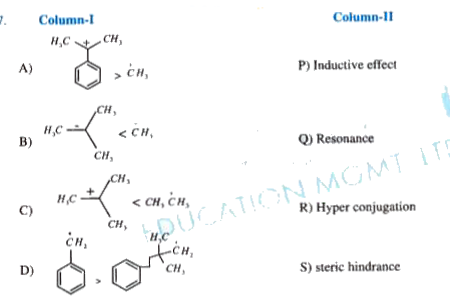Which of the following is the correct order of strength of necleophiles in polar aprotic solventsSolution in Telugu
C2H5¯¯¯O
(CH3)3C¯¯¯O<CH3¯¯¯O
CH3¯¯¯O>¯¯¯OH
RCO¯¯¯O>RCOOH
The correct Answer is:A, B, C, D
Step by step video, text & image solution for Which of the following is the correct order of strength of necleophiles in polar aprotic solvents by Chemistry experts to help you in doubts & scoring excellent marks in Class 11 exams.
Topper's Solved these Questions
- BOOK - AAKASH SERIESCHAPTER - ELECTRONIC EFFECTS AND REACTION INTERMEDIATESEXERCISE - PRACTICE SHEET - EXERCISE-II (LEVEL - II Linked Comprehension Type Questions)3videos
ELECTRONIC EFFECTS AND REACTION INTERMEDIATES
- BOOK - AAKASH SERIESCHAPTER - ELECTRONIC EFFECTS AND REACTION INTERMEDIATESEXERCISE - PRACTICE SHEET - EXERCISE-II (LEVEL - II Matrix Matching Type Questions)2videos
ELECTRONIC EFFECTS AND REACTION INTERMEDIATES
- BOOK - AAKASH SERIESCHAPTER - ELECTRONIC EFFECTS AND REACTION INTERMEDIATESEXERCISE - PRACTICE SHEET - EXERCISE-II (LEVEL - II Straight Objective Type Questions)9videos
ELECTRONIC EFFECTS AND REACTION INTERMEDIATES
- BOOK - AAKASH SERIESCHAPTER - ELECTRON MIGRATION EFFECTS EXERCISE - QUESTIONS FOR DESCRIPTIVE ANSWERS10videos
ELECTRON MIGRATION EFFECTS
- BOOK - AAKASH SERIESCHAPTER - ELEMENTS OF BORON FAMILYEXERCISE - OBJECTIVE EXERCISE - 37videos
ELEMENTS OF BORON FAMILY
Similar Questions
The products of bond breaking, shown below, are not stable, and cannot be isolated for prolonged study. Such species are referred to as reactive intermediate, and are belived to be transient intermediates in many reactions. The general structures and names of four such intermediates are, Charged Intermediates Uncharged Intermediates

Carbocations (called carbonium ions in the older literature) are electrophiles and carbananions are nucleophiles. Carbenes have only a valence shell sextet of electrons and are therefore electron deficient. In this sense they are elecrophiles, but the non-bonding electron pair also gives carbenes nucleophilic character. As a rule, the electrophilic character dominates carbene reactivity. Carbon radicals have only seven valence electrons, and may be considered electron deficient, however, they do not in general bond to nucleophilic electron pair, so their chemistry exhibits differences from that of conventional electrophiles. Radical intermediates are often called free radicals. Intermediates are in general stabilised with conjugation, electron donating and electron with drawing groups.
Which of the following is relatively an unstable intermediate compared to rest ?02:16View SolutionMatch the following columns
 02:58View Solution
02:58View SolutionWhich one of the following is the most stable alkene?
03:21View SolutionHyperconjugation effect is also termed as 'no bond resonance'. Why?
03:02View SolutionWhich one of the following compounds is not a protonic acid ?
02:35View SolutionWhich of the following is polar aprotic solvent ?
03:21View SolutionIdentify the following solvents as polar protic (PP) , polar aprotic (PA), nono-polar protic (NPP) or non-polar aprotic (NPA)
 05:16View Solution
05:16View SolutionWhich of the following solvents are aprotic?
04:56View SolutionWhich of the following are aprotic solvents?
01:28View SolutionWhich is more reactive nucleophile in polar aprotic solvent ?
03:49View SolutionWhich of the following solvents are aprotic?
View SolutionHow many of the following are polar aprotic solvents?
 53:58View Solution
53:58View Solutionউদাহরণ দাও: একটি অ্যাপ্রোটিক ধ্রুবীয় দ্রাবক।
06:38View SolutionWhich of the following is /are aprotic solvents
05:52View SolutionWhich of the following is / are polar aprotic solvents
02:58View Solution

